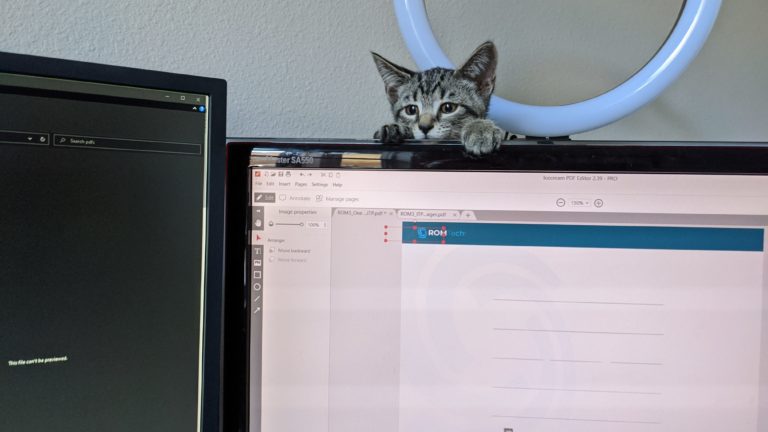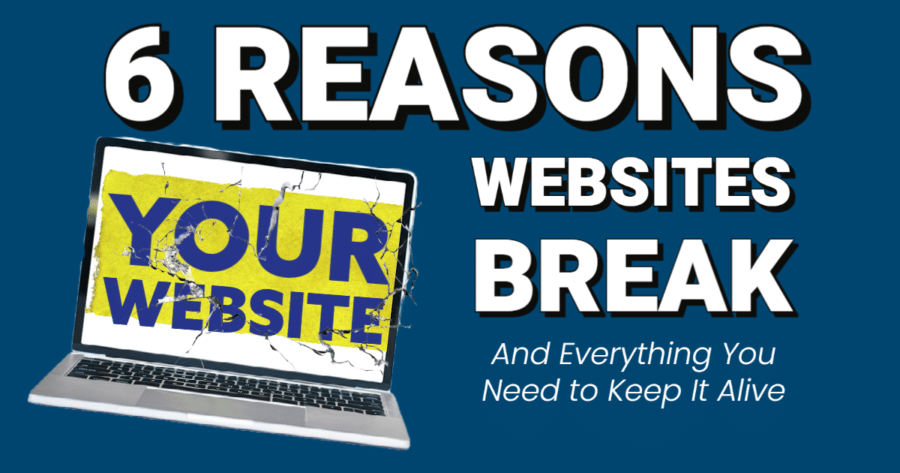Despite their significance and prevalence in day to day life, websites are not immune to technical difficulties and breakdowns. Such an occurrence is generally bad for everyone involved: for businesses, website downtime can result in lost revenue, missed opportunities, and damage to their reputation. For users, encountering a broken website can be frustrating, leading to a poor user experience and a negative perception of the brand associated with it.
And the worst part about it? Websites always seem to break when you need them most.

So why do websites crash? What causes these mishaps to affect even the more simple web content? While definitely not exhaustive, we at Websites in a Flash are here to explain the 6 main reasons why websites break.
Reason 1: Poor Website Maintenance
Regular website maintenance is of paramount importance to ensure smooth and reliable performance. Neglecting essential maintenance tasks can gradually accumulate technical issues that eventually lead to website breakdowns; just like any other complex system, websites require regular upkeep to function well.
Especially for Content Management Systems (CMS) like WordPress, failure to perform routine maintenance can result in various technical issues. Outdated plugins or software versions may introduce security vulnerabilities, leading to potential breaches and data loss. Also, ignoring performance optimization can cause slow loading times, frustrating users and driving them away.
So what does website maintenance look like? Some essential maintenance tasks include:
- Updating your CMS, plugins, and themes.
- Ensuring backups are performed regularly.
- Monitoring website analytics for performance insights.
- Conducting security audits.
Each task plays a crucial role in preserving website functionality, security, and user experience: this is the main reason we started our WordPress Management Service, WordPress Watchdogs!
Reason 2: Inadequate Security Measures
Unfortunately, in today’s digital world, the threat of cyberattacks on websites continues to grow. Hackers constantly seek vulnerabilities to exploit, making it crucial for website owners to prioritize robust security measures. Keeping up with the ever evolving landscape is especially important as cybercriminals employ various techniques, such as malware injections, DDoS attacks, and brute-force attacks, to compromise websites.
A website with weak security measures becomes an easy target for hackers. Breached websites can suffer from stolen customer data, compromised user accounts, and even reputational damage. Additionally, search engines may flag compromised websites, leading to a loss of organic traffic and decreased visibility.

Implementing robust security measures is vital to protect websites and their users. This includes using secure and up-to-date software, employing encryption protocols (e.g., HTTPS), implementing strong authentication mechanisms, and regularly scanning for vulnerabilities. Training staff on best security practices, such as strong password management and awareness of phishing attempts, also contributes to a more secure website environment.
Reason 3: Compatibility Issues
With the proliferation of web browsers, devices, and operating systems, websites must be designed and developed to work seamlessly across different environments. Each browser has its own rendering engine, and devices vary in screen sizes and capabilities. Additionally, platforms like mobile devices and assistive technologies introduce additional considerations for compatibility. When a website is not compatible with certain browsers or devices, it may display incorrectly, have broken layouts, or experience functionality issues.
One problem WordPress websites in particular have to be wary of is that a lot of plugins can have conflicts between one another. Most often this can happen if the plugins share a function name.
Some other common compatibility issues include:
- Inconsistent CSS rendering.
- JavaScript compatibility conflicts.
- WordPress Plugin that is no longer supported.
- Responsiveness problems on mobile devices.
To address these issues, Websites in a Flash recommends adopting the following best practices such as keeping your software up to date, performing regular cross-browser testing, utilizing responsive web design techniques, and employing progressive enhancement or graceful degradation strategies.
Reason 4: Coding Errors and Bugs
Writing clean and efficient code is essential for maintaining a stable and reliable website. Well-structured code improves readability, makes debugging easier, and reduces the likelihood of errors. Efficient code also contributes to faster loading times and better overall performance.
Common coding errors include syntax mistakes, incorrect variable usage, inadequate input validation, or insecure coding practices.
To prevent these errors, developers should adopt best practices like code review processes, using coding standards, performing thorough testing, and staying updated with the latest programming techniques and security practices. When we create our Custom Website Designs, we also hand-code the WordPress Theme from scratch, so we can reduce errors and bugs from today’s over-built themes.

Reason 5: Hosting Problems
Hosting problems such as server crashes, network outages, or inadequate server resources can result in website downtime. This can occur due to technical issues on the hosting provider’s end or insufficient resources allocated to handle website traffic.
A reliable hosting provider ensures that websites are hosted on stable servers with sufficient resources and optimal uptime. Reliable providers offer technical support, regular backups, and robust infrastructure to minimize the risk of downtime.
To address these issues, we always recommend hosting WordPress websites on cloud servers like Cloudways. You can also use plugins to improve website speed when you can’t change servers.
Reason 6: Traffic Overload
When a website receives more traffic than it can handle, it may experience slow loading times, unresponsive pages, or even crashes. This can occur during periods of high demand, such as during a viral social media campaign or a significant event.

To handle traffic spikes, websites must have a scalable infrastructure and sufficient server capacity. Scalability allows websites to accommodate increased traffic without sacrificing performance. Adequate server capacity ensures that resources, such as processing power, memory, and bandwidth, are available to handle the influx of visitors. Other strategies for managing website traffic include utilizing content delivery networks (CDNs) to distribute content geographically, caching frequently accessed content, optimizing database queries, employing load balancing techniques, and leveraging cloud hosting services that offer scalable infrastructure.

Download Your Free Guide Now!
Be Good To Your Websites And They Will Be Good To You!
Like any responsibility, your website’s health and longevity depend on your consistent and effective attention. Whether it is poor website maintenance, inadequate security measures, compatibility issues, coding errors and bugs, hosting problems, and/or traffic overload, website breakdowns generally revolve around some form of oversight or lack of care. Ultimately, your website’s success is almost guaranteed if you devote the necessary time and resources to its upkeep.
Many business owners don’t have the time or expertise to make sure their website doesn’t break. If that’s you, we just released our new WordPress Management Program:

